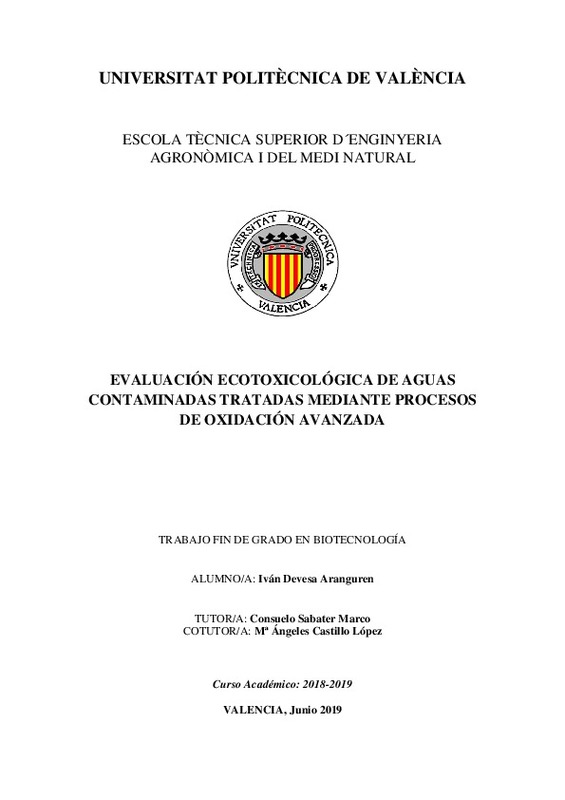|
Resumen:
|
[ES] En los últimos años, ha aumentado la preocupación por el creciente número de compuestos tóxicos detectados en el medio ambiente, por ello, se ha instaurado una legislación con el fin de proteger los ambientes acuáticos, ...[+]
[ES] En los últimos años, ha aumentado la preocupación por el creciente número de compuestos tóxicos detectados en el medio ambiente, por ello, se ha instaurado una legislación con el fin de proteger los ambientes acuáticos, destacando en Europa la Directiva Marco del Agua (DMA), aprobada por el Parlamento Europeo en el año 2000. Desde entonces ha ido recibiendo revisiones con el objetivo de actualizar las sustancias prioritarias y su análisis para establecer unas normas de calidad ambiental.
No obstante, siguen saliendo al mercado nuevos compuestos químicos cada año y hay otros que, pese a estar presentes desde hace mucho tiempo, se ha detectado su presencia recientemente en el medio por el continuo avance de las técnicas analíticas. Estos son los llamados contaminantes emergentes o microcontaminantes, que debido a su falta de regulación en la legislación actual y al desconocimiento de sus efectos a corto y largo plazo sobre el ambiente y los organismos que lo pueblan, se han convertido en una prioridad para los investigadores.
Estos compuestos son incorporados al medio ambiente por la actividad industrial, agrícola y por efluentes de estaciones depuradoras de aguas residuales, donde, en muchos casos, no se consigue una eliminación completa de los mismos. Es por ello que se están desarrollando nuevas tecnologías para conseguir una completa eliminación de este tipo de sustancias como los Procesos de Oxidación Avanzada (POAs). Estos procesos se clasifican en dos grandes grupos, en función de cómo se generan los radicales hidroxilo, es decir, por medios fotoquímicos o medios no fotoquímicos, como la ozonización.
Además de evaluar la eficacia de estos tratamientos a nivel de su degradabilidad, se hace necesario determinar la toxicidad real de las muestras tratadas y sus potenciales efectos en el medio ambiente, ya que los contaminantes originales pueden convertirse en subproductos de toxicidad desconocida. En los últimos años, se ha realizado un esfuerzo considerable para desarrollar procedimientos y protocolos para la realización de bioensayos o test de toxicidad con diferentes especies de organismos de diferentes niveles en la escala de organización biológica. De manera que, gracias a ellos, es posible determinar la eficacia de los tratamientos de las aguas tratadas desde un punto de vista ecotoxicológico y su posible impacto en el medio ambiente.
En este trabajo de investigación, aguas simuladas y naturales artificialmente contaminadas con cuatro microcontaminantes presentes en la Directiva 2013/39/CE, diclofenaco, pentaclorofenol, terbutrina y clorfenvinfos, y sometidas a Procesos de Oxidación Avanzada (Foto- Fenton y ozonización) van a ser evaluadas mediante la realización de una batería de bioensayos que representen varios niveles tróficos del medio, como son la bacteria marina luminiscente Aliivibrio fischeri, el alga unicelular de agua dulce Pseudokirchneriella subcapitata, el invertebrado Daphnia magna y la lombriz de tierra Eisenia fetida, organismo modelo para la toxicidad del suelo.
[-]
[EN] In the recent years, concern has been raised about the increasing number of toxic compounds detected in the environment. Therefore, legislation has been introduced to protect the aquatic environments, highlighting in ...[+]
[EN] In the recent years, concern has been raised about the increasing number of toxic compounds detected in the environment. Therefore, legislation has been introduced to protect the aquatic environments, highlighting in Europe the Water Framework Directive (WFD), approved by the European Parliament in the year 2000. Since then it has received several reviews with the aim of updating the most important substances and their analysis to establish environmental quality standards.
However, new chemical compounds continue to be released every year and there are others that, despite being present for a long time, have recently been detected in the environment due to the continuous advance of analytical techniques. These are the so-called emerging pollutants or micropollutants, which due to their lack of regulation in the current legislation and the ignorance of their short and long term effects on the environment and the organisms that populate it, have become a priority for researchers. .
These compounds are incorporated into the environment by industrial, agricultural and effluent activity of sewage treatment plants, where, in many cases, a complete elimination of them is not achieved. That is why new technologies are being developed to achieve a complete elimination of this type of substances, such as Advanced Oxidation Processes (POAs). These processes are classified into two large groups, depending on how the hydroxyl radicals are generated, that is, by photochemical means or non-photochemical means, such as ozonation.
In addition to evaluating the effectiveness of these treatments in terms of their degradability, it is necessary to determine the real toxicity of the treated samples and their potential effects on the environment, since the original contaminants can become by-products of unknown toxicity. In the recent years, a considerable effort has been made to develop procedures and protocols for carrying out bioassays or toxicity tests with different species of organisms of different levels in the scale of biological organization. Thanks to them, it is possible to determine the effectiveness of the treatment of treated water from an ecotoxicological point of view and its possible impact on the environment.
In this research paper, simulated and natural waters artificially contaminated with four micropollutants present in the 2013/39 / EC Directive, diclofenac, pentachlorophenol, terbutrine and chlorfenvinphos, and subjected to Advanced Oxidation Processes (Photo-Fenton and ozonation) are going to be evaluated by performing a battery of bioassays that represent several trophic levels of the medium, such as the luminescent marine bacterium Aliivibrio fischeri, the unicellular freshwater algae Pseudokirchneriella subcapitata, the invertebrate Daphnia magna and the earthworm Eisenia fetida, a model organism for the toxicity of the soil.
[-]
|







